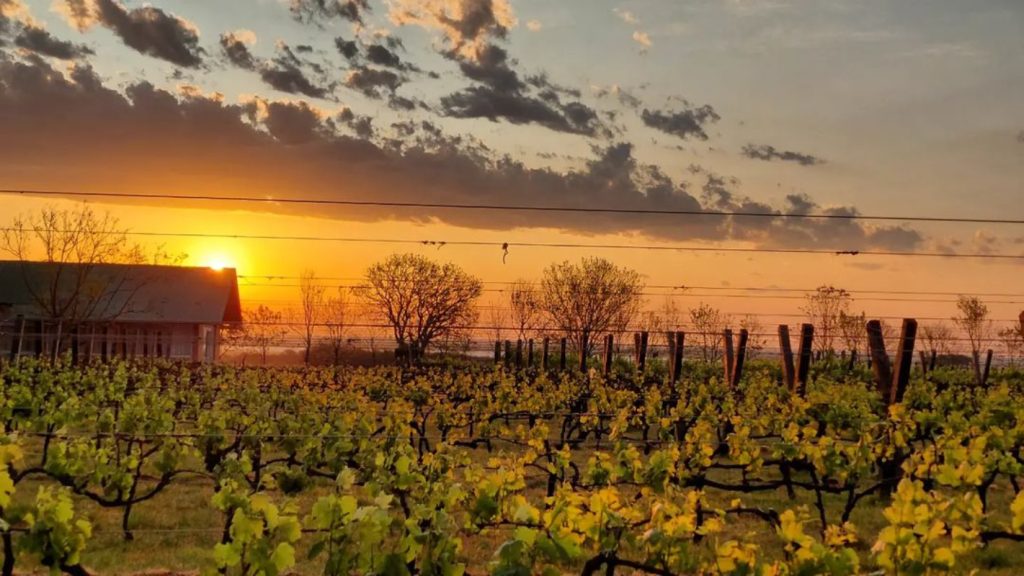With over 60 hectares under vine and more than 60 grape producers, 4 wineries, two sparkling wine producers and more than 15 small boutique and garage operations, the wines of Entre Rios stand out for their distinctive fruitiness and adoption of the latest trends. Since 2010, the Entre Rios Association of Viticultural Producers (AVER), whose president is María Jesus Vulliez, the owner of Vulliez Sermet, has helped producers to share their experiences and establish a productive hub to encourage wine tourism.
Wines of Entre Ríos

“Reds with the soul of whites” says oenologist Gabriel Leoni, who is head of production at Bodega Vulliez Sermet, pioneers in Colón who now produce and make wine for 45 brands. “It was one of the many wineries abandoned after the law of prohibition. When the law was repealed in 1997, we revived our grandparents’ project. In 2003 we planted three hectares of vineyard and started to rebuild the winery, which was the first in the province after the ban.”

Julia Lurquin, at Finca Los Teros in Paraná, says, “Our wines are young, fresh and distinctive because the province has a lot of different terroirs.” Just a mile from the Paraná River, the enterprise was founded on February 18, 2009: it has 300 Malbec, Syrah and Chardonnay vines, cordon trained and dry-farmed on a slope where “there’s plenty of sun and a gentle breeze every day.” They also host numerous wine tourism-related events.
Since the 19th century
In this area, adds Mauro Jacob at Bodega Los Aromitos, located in Colonia Ensayo, “We go back to the beginning of the century, when viticulture started to revive in the province.” María Jesús Vulliez at Bodega Vulliez Sermet explains: “It was a wine region from 1860 to 1936; and eventually became the fourth biggest grape producing province. In 1997, when Law 12.137 was repealed, we embarked on a mission to continue an activity that had been the family’s main means of economic support and cultural expression.”
Jacob continues, “It’s quite similar to Uruguay in terms of climate and geography.” The open lyre training system is the best suited for the area. And he also emphasizes the importance of de-budding, green pruning and paring down leaves and bunches.

Flavia Rigoni at Finca Fénix in La Criolla, 10 miles from the Salto Grande international bridge, believes that “the province is experiencing a notable boom as a wine producer because the knowhow is there. There’s a significant group of small producers who joined the sector in recent years who are beginning to expand their capacity.” The project began in 2013 with certified grafts from Mendoza. Fenix provides a unique experience in the province, the “Entre Rios Harvest”, at which visitors can get involved in the harvest, grape pressing and wine tasting.
The best adapted varieties are Tannat (which came to the region in 1860), Merlot, Malbec, Syrah, Marselan and Chardonnay. Jacob notes: “The wines of Entre Rios are now beginning to include whites and sparkling wines as well.”
A unique style

The province has a wealth of diverse soils, climates and micro-climates all of which have an effect on the wines in a province that can present producers with challenges. “The wines deliver a wide range of aromas and flavors because of the distinctive characteristics of the terroir, which means that a variety can taste quite different from one vineyard to the next.
That’s a very positive aspect of our wines because it allows us to make products that have unique expressions from one year to the next,” says Daniel Giménez, the owner of Viñedos del Río, which the agricultural engineer founded in 2013 in Concepción del Uruguay after working in Uruguay and deciding to apply his knowledge in Entre Rios. He began with Merlot and Syrah and in subsequent years added Chardonnay, Cabernet Franc and Marselan.

“If you draw a line between Paraná and Concordia you see Pampas plains to the south and an area of espinillo forest to the north. In the La Paz area, you find an area of delta estuaries and in our case, meadowland,” says Ana Jacobi at Juan Girbich Vinos Caseros, in Crespo. The winery began in 2011 in a very small space.
“We decided to do some research with INTA Mendoza into nurseries, costs and such. When my husband got back, he said, ‘I bought 500 Marselan plants,’” says Ana Maria Jacobi. Today the project has 600 Marselan plants and 1000 Malbec vines, with which they produce 2000 liters a year, selling the wine under the name j/g Juan Girbich Vinos Caseros. Jacobi says, “The differentiating quality of our wines is that they’re from meadowlands, damp plains with wild, sandy areas, native yeasts and excellent quality.”
The Future
“Entre Ríos has the qualities to produce very aromatic wines with pronounced natural acidity. Our area is affected quite markedly by the conditions experienced with each vintage,” says Giménez. Jacob believes: “This is an emerging region with great potential that is growing vigorously, founded in a rich viticultural history. Tannat is establishing itself as the flagship variety and Marselan and other whites such as Chardonnay and Viognier may well be very important in the future. The growth of wine tourism is key for the promotion of viticultural activity.”
Producers of the wines of Entre Rios are extremely optimistic about how the region is developing and believe that the future will involve plenty of growth. The ability to grow vines without having to draw on water from the river for irrigation due to the plentiful rainfall is an enormous advantage compared to other wine producing regions in the country. Many say that dry farming is the future for large vineyards. In Entre Rios, there is an opportunity to make a fully exportable product: fresh, fruity wines with lower alcohol content and, most important of all, a sustainable outlook – exactly what the world is asking for.



